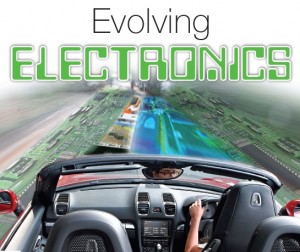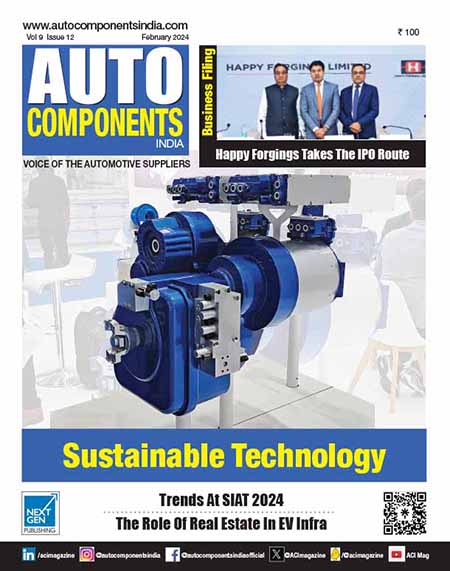Text : T Murrali
 Vehicles, irrespective of the segments they operate in, are developing and progressing day by day due to many factors that include performance improvements, safety, emission regulations and increased comfort and convenience. Vehicle manufacturers achieve this largely by the increasing use of electronics. While this phenomenon creates immense potential for the electronics, semiconductor and software industries, there are challenges that come along like potential safety and environmental hazards that include recyclability and reliability.
Vehicles, irrespective of the segments they operate in, are developing and progressing day by day due to many factors that include performance improvements, safety, emission regulations and increased comfort and convenience. Vehicle manufacturers achieve this largely by the increasing use of electronics. While this phenomenon creates immense potential for the electronics, semiconductor and software industries, there are challenges that come along like potential safety and environmental hazards that include recyclability and reliability.
Right from the early stages, innovations in the automotive industry have been based on electronic components and software. The megatrends that suppliers to this industry follow are energy efficiency and emission reductions, nullifying traffic-related deaths and staying connected. Besides, the shift in demand for cars from developed countries to emerging countries creates additional demands for the industry.
Speaking to Auto Components India, Swamy Kotagiri, Chief Technology Officer, Magna International based at Troy, Michigan in the US, said electronics is to define functionalities that are determined by the overall objectives of the OEMs based on environment, legal requirements etc. Thus, electronics and software are the enablers for the evolution of products from today to tomorrow.
In developed markets there is safety electronics such as ESP, ABS and traction control. Now it is expanding into proximity warning and adaptive cruise control. “These are essentially no longer just electronics but complete driver integration systems and driver control modules,” says the leading industry expert and former Vice Chairman, Ashok Leyland Dr V Sumantran. “We are beginning to see some pieces of it in India – for instance there is reverse park assist, reverse camera and parking sensors. We are approaching it from a very low base. In India, Google Graphics has got reasonably good updated information. We are seeing more and more people becoming owner-drivers rather than employing drivers. With traffic durations unplanned, it is necessary to have better tools. We see the need for information fusion for the cars in India as they are in the overseas market.”
According to T S Srikanth, General Manager, Technical Sales, Visteon Electronics, there is a huge opportunity and its equivalent challenge in terms of maximising consumer experience, in the emerging ‘Internet of Things.’ Bringing in ‘consumer experience’ with integrating heterogeneous systems for diverse stakeholders viz., government agencies, various devices and its associated protocols and standards, growing consumer expectations and personalisation requirements, regulatory bodies, OEMs expectation and their differentiation requirements, are huge challenges. Diverse opportunities motivate generation of product innovation, thereby meeting not only domestic but also global needs.
There are several opportunities and challenges for OEMs and system suppliers with vehicles becoming more than just a mode of transport. The CEO of India Nippon Electricals Limited, Subhasis Dey sees several opportunities in all the vehicle segments; fuel injection systems across the board in 2-wheelers, connectivity for roadside assistance, immobilisers for theft proofing and locating vehicles in parking lots, air-bags and ABS in 2-wheelers and commercial vehicles. However, deficient infrastructure, lack of uniformed policies, and rising costs are a few of the challenges to be tackled.
With constant growing requirement for environmental protection as the end users are demanding greater fuel efficiency, security and safety – electronic equipment is becoming a major part of vehicles rather than just being an addition to the vehicle, opines Frank Wang, President, Asia Pacific, Delphi Electronics & Safety. Cars, which used to have only mechanical systems, now contain more than 1,000 electronic components including sensors and micro-controllers. All the trends in the industry point to a convergence of the automotive and electronics industries that is literally transforming automobiles.
R K Shenoy, Senior Vice President – Robert Bosch Engineering and Business Solutions Limited (RBEI), who is responsible for Powertrain Electronics says the future would see India focusing more on exhaust after treatment with particulate filter and DNOX, use of alternate fuels mainly CNG, AMT and hybridisation instead of electrification since India is underpowered in electrical energy. However, the major challenge is satisfying customers on ‘features versus cost.’ “Readiness to pay will only increase if we are able to showcase the ‘values’ in this segment,” he adds.
Ashok Chandak, Chairman, India Electronics and Semiconductor Association (IESA) opines that smartphone connectivity in the car is the next trend. People have started to pay for better features of convenience and safety. “In 5 years from now car-to-car and car-to-infrastructure communication will gain momentum and deployment,” he declares.
Smart electronics, once present only in the luxury car domain, is now an integral part of entry level cars as well. Is this trend translating into opportunities? Srikanth sees this as a key driver for electronics content in the vehicle. Besides, it adds to consumer awareness and growing credibility on electronic controls, in addition to driving more convergence of electronics in the vehicle. “We do market research to understand ‘value zone for features’ which provides a thin line between features and consumers’ willingness to pay. This would help us suggest to OEMs on what could be the features considered for entry level but still within consumers’ affordable region, and what features could be luxury. However, this gap is reducing,” he adds. Dey says that the lower penetration of cars in India coupled with the narrowing price band between them and 2- wheelers raise the demand for entry level vehicles. With emission norms becoming stringent by the day, OEMs encourage electronic manufacturers to engender innovative ideas, and are willing to work together with them.
Delphi’s Wang says connectivity and computing that is driving infotainment type content in the vehicle is currently a $14 billion market and growing. These technologies are really taking-off in the US and EU. The technology is becoming affordable, and it is democratising. Taking an analogy from the cell phone industry, he says, smartphone’s and tablets are selling at a record pace.
More than a billion smartphones were sold worldwide over the last year with Asia Pacific leading the pack. And analysts have said that new smartphone sales account for more than half of global mobile phone sales now. So the potential for increased volume and revenue generation from that volume is expected to be significant in the coming years. Agreeing to the point Shenoy adds that the cost of bringing smart electronics/features in the entry level cars will come down with increasing consumer awareness, volumes and spending power. Companies that are able to innovate and be agile in development, manufacturing products at lower costs, would stand to gain in the long term. Chandak counters this by saying that it will take time before volumes ramp up. Most of the people right now want to connect the smartphones to their cars, but built-in smart electronics will take a few years for deployment.
Som Choudhury, Managing Director, Analog Devices India, opines that severe competition among car manufacturers has resulted in technologies that were available only in the high end of the spectrum migrating quickly down to the mid and even the lower end of the segment. “Today Indian customers are still choosing a car mostly based on the connectivity, audio, telematics options and fuel efficiency, and less so based on the safety of the car. Unfortunately, India has one of the highest deaths in road accidents in the world and there is an urgent need of driver education and strict regulation.”
Collaborative Efforts
No doubt the use of more electronics will improve efficiency, which is paramount for vehicle manufacturers. On the positive signals that emerge from the OEMs and system suppliers Sumantran says the evolution has begun to see a new breed of supply chain emerge, like in Microsoft, Apple, Blackberry and Google. Along with this there are new suppliers like Flextronics and others coming in to the combination of hardware development and functionalities. To that extent the auto industry is starting to engage with a completely new supply chain. Even some of the hardcore and traditional automotive suppliers are now moving in to develop electronics.
Concurring, Kotagiri says the entry of new players into the market is important because they have experience in certain domains. It is equally important to understand the OEMs’ legal, safety and reliability requirements. The future will see consolidation or an amalgamation of these domains; the OEMs and traditional suppliers understand the need for requisite skill sets, and they continue to develop. As software and hardware are two sides of the coin, suppliers will play the role of an integrator in future. “The new supply chain will not dislodge the traditional vendors but continue to be complementary. It may end up like what we see in the smart phone business; Google has a layer of functionality and software in any Android device. However, periodically they buy hardware companies to strengthen the presence,” he adds.
Pain Points
Well, what are the pain points of increasing electronic content in vehicles manufactured in India? According to Srikanth there are no major impediments to growth other than challenges in terms of non-availability of local electronic components. It results in more of import content which is a challenge considering the currency fluctuations. Lack of a clear roadmap and commitment on regulatory requirements or evolution of standards like digitisation etc. is some of the impediments.
The obvious challenge, Kotagiri feels, is that electronics is significant in consumer products like phones, televisions etc. So, it is mostly driven by the migration of different segments and the integration of items having different product lifecycles. Therefore, the challenge is to provide a system that is tethered to the existing arrangement or offer a gateway into the vehicle enabling inflow of many other implements of electronics.
The impediments, Sumantran says, will be from the escalation in cost and the system liability. As the end customers are not willing to pay more for the soft features, the pressure on margins for the OEMs increase. Secondly, the increase in electronics proportionately adds to related failures. However, there is disproportionate increase in quality defects traceable to electronics and software. Many OEMs have seen a number of quality issues and defects emanate from the combination of electronics and software.
Exponential growth in cellular and consumable electronics products is hampering supply chain management of electronics components across India, avers Dey. In the case of component failures, it has to be sent to the manufacturers for analysis who are located in different parts of the world, eventually delaying the investigation. “In the meanwhile we have to run the production with an assumption that there could be few more such failures. Besides, the cost of electronics components is high as almost all semi conductor devices are imported,” explains Dey.
Expressing his views Wang says some of the challenges include developing economical, technologically advanced, robust technologies and building a strong talent pool with technical capabilities. Auto companies are looking for more realistic targets especially in terms of customer satisfaction due to constantly increasing competition as customers have more options available to them. Indian and international players are competing in a similar manner. Wherein international players are leaders in introducing revolutionary and proven auto technologies that prevail worldwide and have huge relevance for the domestic market, Indian companies conquer in terms of pricing. Secondly, high level of investments is another challenge. The scale of operation and inability of many to come out of the operational work flow and working capital fund requirements leaves less time for strategic planning and building up of growth avenues.
Many companies are caught in the lower tiers of the component value chain. Moving to a higher level and catering to a broader customer base requires investment in managerial talent, marketing, R&D and production. Companies in India operate at very low scales of production and this hinders their ability to cater to international markets. Capturing a certain scale of operations is very critical to the company’s growth path. Counterfeits are also a major issue for the industry. They hamper the overall performance of vehicles and prove to be a big deterrent in the growth of electronics in vehicles as well, asserts Wang.
Shenoy informs that consumers no longer accept standardised products; they want products that satisfy their individual requirements. People are looking for more value by having features from consumer electronics into their cars like navigation and other Apps on mobile phones, rather than inbuilt systems with sophisticated features and synchronization between mobile and built-in systems. Chandak opines that India is still a sensitive market; more than 75% of cars sold in the country are priced below Rs 5 lakh. Indians want the best features within their concept of value for money. This creates challenges for car makers but also offers an opportunity to innovate and be different.
Allied Advantages
Electronics and the new breed of suppliers give opportunities to OEMs in more ways than one. In addition to offering several advantages discussed above, will it help them in extrapolating their USP and use it as a selling tool? “Yes, I suppose so,” says Sumantran. For instance, the Fiat Blue and Me, the Bluetooth connectivity, developed with Microsoft, is talked about more as a feature of the car. Therefore, it is no longer just providing better performance but becomes a branded selling point. The USP of a vehicle might in some cases shift from the functional point of view to new soft features.
The USP for OEMs to sell a car is majorly based on the features rather than the vehicle as a whole, opines Kotagiri. Moreover, the features in the cars based on electronics and software get obsolete faster than the vehicle and, therefore, the challenge for the system suppliers and the OEMs is to provide a framework in the vehicle to facilitate seamless integration of user expectations. This is because there is going to be a paradigm shift in what is offered in the vehicle that helps transition the life of the user from outside of the vehicle to the inside. Hence, it is necessary to offer safety and reliability on one side and comfort and convenience on the other. OEMs look at how to make the user experience in the car emotionally attached to their brand names. “My belief is that one cannot separate it from influence outside the industry like consumer electronics and such things, which is not only huge but also fast,” views Kotagiri. India is still mainly the ‘fuel-efficiency advertised’ market. Despite being cost sensitive, electronics is the key enabler of fuel efficiency in automobiles, says Chandak.
Way for Electronics in India
Electronics in vehicles can be focusing on functional or convenience aspects. In India, it will be functional, in terms of complying with emission norms etc, to some extent and customer convenience to a large extent. The traditional approach is to look for a long term development contract; however, the architecture keeps changing fast making the developments obsolete. It is a dual challenge – one is in favour of long term partnership while the other supports faster obsolescence.
Srikanth believes that this is more than just functionality or convenience, as it also includes prominent importance for other attributes like, ‘accommodative, easy, safe, intuitive, comfort, secure, alerting, entertained, connected etc.’ For instance, when the cockpit developed by the company was tested with North American consumers, safety was mostly voted for whereas in India, it is totally different.
Dey is of the view that more electronics will get into vehicles on the functional side in the immediate future, and later on for convenience aspects. For the youth, convenience electronics becomes functional electronics.
India, according to Wang, is engaged in cutting-edge software in systems development for the very complex vehicle electronics architecture and some of the newer vehicles are smartly employing contemporary next generation electronic architecture. Today, an average new automobile includes more than 40 electronic controllers, 5 miles of wiring, and more than 10 million lines of software code with some of the smart electronic advances in vehicles like all-wheel drive, air bags, GPS etc. There are several technologies emerging to ensure and sustain a number of notable disruptions and transformations in the automobile industry. In addition to making driving simpler, safer, and satisfying, the electronic advancements would be to make vehicles more productive through the use of e-learning, e-commerce, entertainment, gaming, and infotainment.
India Trailing
Despite India’s contribution to global software development being significant, the electronic content in vehicles is not matching the levels of developed countries. To this occurrence, Sumantran sees problems in several layers. “Firstly, in India we have bemoaned the fact that the hardware industry or the electronics industry has been woefully left behind. There have been many initiatives including wafer fabrication, semiconductors etc., yet the prevailing concern at the country level is the increase in imports. Our import bill for electronics is forecast to be higher than the oil bill by 2025 and this is a serious issue. An indictment to the fact is that India is not really scaled up with electronics manufacturing. Therefore, it is necessary to scale up manufacturing,” he says.
Secondly, “as we have seen in smart phone business, this is one where the application has to be global and the obsolescence rate is high. In India, we have always done pieces of the big picture but never integrated with the global arena; for instance, Flextronics is manufacturing but build to print. Unless our supply chain acquires the capability, we risk further being commoditised. This is to some extent the business that uniquely combines the Silicon Valley innovation or functions and application with the huge scale that is seen in China and Taiwan for manufacturing electronics,” announces Sumantran.
India is not able to catch up due to absence of infrastructure, claims Kotagiri. Infrastructure will pave the way for the proliferation of vehicles; it is not the lack of buying power that is restricting.
Countering the argument Srikanth says, “We don’t think this is the case, especially with companies like Visteon and other global Tier-1 suppliers. We directly leverage our global manufacturing expertise from developed markets like Europe. It completely matches the global process and quality levels. We are driven by same process elements globally and our organisation structure itself is built on that premise.” Dey states that it is mainly due to affordability, which is higher in developed countries when compared to India. Besides, availability of electronic parts also plays a major role. The end consumers do not get a tangible benefit; however, due to impact of emission, there will be a cost element.
Shenoy says that the cost of electronics is high since most of them still have high import content due to low volumes in India. With the increase in vehicle volumes and offerings in lower segment vehicles, the cost of these locally developed and manufactured electronic items would come down, making them, in turn, affordable. OEMs and Tier-1s need to focus on this aspect and strategically collaborate to make this happen. At the end consumers would benefit.
Chandak opines that the design and development of the ecosystem in automotive electronics is developing very fast. Though several global players have set up their design operations, some of the Indian companies are also ramping up through global joint ventures. The electronic content in cars is much lower than global cars due to reasons of low cost cars that India produces. The affordability is improving but still 75% of the cars sold in India are below the Rs 5 Lakh price tag. This limits the amount of money that can be spent on the electronics. As per IESA estimates India makes 65% of the auto electronics in India and imports 35%. And the trend is changing with more and more local design/customisation and manufacturing happening in India.
Way Forward
According to IESA estimates the total automotive electronics market was $3.4 billion in 2013 and is growing at a CAGR of 10.2%. Depending on the OEM, there are a number of ways to design the electronic content and manage cost. As more and more features are upgraded, costs can slump if volumes increase. Nevertheless, local manufacturing will be the key for India to be cost competitive.



















